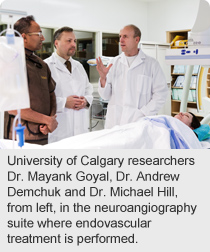
February 12, 2015
Story by Colin Zak; Photo by Riley Brandt/University of Calgary
Basma Khouloussi remembers little of her stroke last August.
“My husband noticed I wasn’t speaking very well and the right side of my body completely stopped working,” says the 41-year-old Calgary woman. “If it hadn’t been for the care I received at Foothills Hospital, who knows where I would be today.”
Thanks to a revolutionary new procedure to treat patients who have suffered a stroke, Khouloussi sustained no long-term side-effects and is now preparing to return to work as an English language instructor.
“I feel like I’ve made a 100 per cent recovery,” she says. “The procedure saved my life.”
Endovascular treatment (ET) is a clot retrieval procedure that has been shown to dramatically improve outcomes for patients after an acute ischemic stroke and reduce the likelihood of death.
In an international randomized trial led by three Alberta Health Services (AHS) researchers based in Calgary, ET reduced mortality rates by 50 per cent – from two in 10 patients to one in 10 patients. The procedure also increased positive outcomes from 30 per cent to 55 per cent. In many cases, rather than sustaining major neurological disability, patients went home to resume their normal lives.
The study included 22 sites worldwide, including Foothills Medical Centre and University of Alberta Hospital. Results of the international randomized study were published in the Feb. 11 online edition of the New England Journal of Medicine.
“This is the most significant and fundamental change in acute ischemic stroke treatment in the last 20 years. These results will impact stroke care around the world,” says Dr. Michael Hill, AHS neurologist with the Calgary Stroke Program and senior author of the study.
“For patients, it means a dramatic reduction in the likelihood of death or disability after a stroke,” adds Dr. Hill, who’s also a professor at the University of Calgary Cumming School of Medicine’s departments of clinical neurosciences and radiology.
The clinical trial, known as ESCAPE (Endovascular treatment for Small Core and Anterior circulation Proximal occlusion with Emphasis on minimizing CT to recanalization times), shows a marked reduction in death and disability among patients who receive ET for acute ischemic stroke.
Ischemic strokes are caused by a sudden blockage of an artery to the brain, depriving the brain of critical nutrients, such as glucose and oxygen. This can cause brain cells to die, affecting parts of the body controlled by that section of the brain. If damage is severe, it can cause death.
Currently, the standard of care in Canada and abroad is to administer a drug called tPA – commonly known as a ‘clot-busting drug’ – when appropriate, to dissolve the blood clot.
In the trial, 316 eligible patients who arrived for treatment within 12 hours of their stroke were randomly selected to receive either standard medical care, including tPA, or standard medical care along with ET.
“Key reasons for the success of the trial were selecting appropriate patients using imaging technology, expedited treatment and the use of state-of-the-art imaging technology to view the brain and open the blood vessels,” explains Dr. Mayank Goyal, AHS interventional neuroradiologist, co-principal investigator of the ESCAPE trial and first author on the publication, and professor at Cumming School of Medicine.
“We believe that with the combined results from this trial and other trials, this will become the new standard of care.”
ET is performed by making a small incision at the artery in the groin and inserting a thin tube or catheter. Using an X-ray, the tube is fed into the brain vessel where the clot is located. The clot is then manually removed with instruments inserted through the catheter, restoring blood flow to the brain.
“Many stroke treatments work only if administered in a set period of time,” says Dr. Andrew Demchuk, another ESCAPE co-principal investigator and leader of the Stroke Program at Foothills Medical Centre and the Hotchkiss Brain Institute Stroke Team.
“Many patients don’t get to the hospital in time. With stroke, every minute matters.”
Dr. Hill says Alberta truly led the ESCAPE trial, with Calgary and Edmonton as the top enrolling sites.
“Because we were leaders in the trial, now that the treatment is proven, we will be able to offer it immediately to stroke victims in the province,” he says.